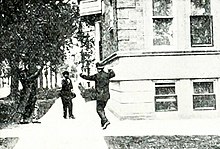
The Motion Picture Patents Company, founded in December 1908 and effectively terminated in 1915 after it lost a federal antitrust suit, was a trust of all the major US film companies and local foreign-branches, the leading film distributor and the biggest supplier of raw film stock, Eastman Kodak. The MPPC ended the domination of foreign films on US screens, standardized the manner in which films were distributed and exhibited within the US, and improved the quality of US motion pictures by internal competition. It also discouraged its members' entry into feature film production, and the use of outside financing, both to its members' eventual detriment.

Essanay Studios, officially the Essanay Film Manufacturing Company, was an early American motion picture studio. The studio was founded in 1907 in Chicago by George Kirke Spoor and Gilbert M. Anderson, originally as the Peerless Film Manufacturing Company, then as Essanay on August 10, 1907. Essanay is probably best known today for its series of Charlie Chaplin comedies produced in 1915-1916. In late 1916, it merged distribution with other studios and stopped issuing films in the fall of 1918. According to film historian Steve Massa, Essanay is one of the important early studios, with comedies as a particular strength. Founders Spoor and Anderson were subsequently awarded special Academy Awards for pioneering contributions to film.

The Biograph Company, also known as the American Mutoscope and Biograph Company, was a motion picture company founded in 1895 and active until 1916. It was the first company in the United States devoted entirely to film production and exhibition, and for two decades was one of the most prolific, releasing over 3000 short films and 12 feature films. During the height of silent film as a medium, Biograph was the most prominent U.S. film studio and one of the most respected and influential studios worldwide, only rivaled by Germany's UFA, Sweden's Svensk Filmindustri and France's Pathé. The company was home to pioneering director D. W. Griffith and such actors as Mary Pickford, Lillian Gish, and Lionel Barrymore.

Ben Hur is a 1907 American silent drama film set in ancient Rome, the first screen adaptation of Lew Wallace's popular 1880 novel Ben-Hur: A Tale of the Christ. Co-directed by Sidney Olcott and Frank Oakes Rose, this "photoplay" was produced by the Kalem Company of New York City, and its scenes, including the climactic chariot race, were filmed in the city's borough of Brooklyn.

Francis Winter Boggs was an American stage actor and pioneer silent film director. He was one of the first to direct a film in Hollywood.
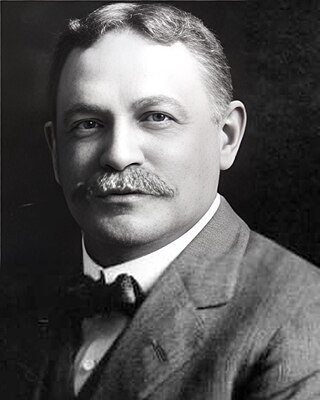
William Nicholas Selig was a vaudeville performer and pioneer of the American motion picture industry. His stage billing as Colonel Selig would be used for the rest of his career, even as he moved into film production.

The Selig Polyscope Company was an American motion picture company that was founded in 1896 by William Selig in Chicago, Illinois. The company produced hundreds of early, widely distributed commercial moving pictures, including the first films starring Tom Mix, Harold Lloyd, Colleen Moore, and Roscoe "Fatty" Arbuckle. Selig Polyscope also established Southern California's first permanent movie studio, in the historic Edendale district of Los Angeles.

Paul William "Tom" Santschi was an American leading man and character actor of the silent film era.
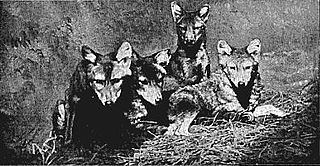
Roosevelt in Africa is a film by Cherry Kearton, released in 1910. It is a documentary about the Smithsonian–Roosevelt African Expedition, featuring Theodore Roosevelt in Africa. It is shot in silent black and white.
Edendale is a historical name for a district in Los Angeles, California, northwest of Downtown Los Angeles, in what is known today as Echo Park, Los Feliz and Silver Lake. In the opening decades of the 20th century, in the era of silent movies, Edendale was known as the home of most major movie studios on the West Coast. Among its many claims, it was home to the Keystone Cops, and the site of many movie firsts, including Charlie Chaplin's first movie, the first feature-length comedy, and the first pie-in-the-face. The Edendale movie studios were mostly concentrated in a four-block stretch of Allesandro Street, between Berkeley Avenue and Duane Street. Allesandro Street was later renamed Glendale Boulevard.

Hobart Van Zandt Bosworth was an American film actor, director, writer, and producer. Bosworth began his career in theater, eventually transitioning to the emerging film industry. Despite a battle with tuberculosis, he found success in silent films, establishing himself as a lead actor and pioneering the industry in California. Bosworth started his own production company, Hobart Bosworth Productions, in 1913, focusing on Jack London melodramas. After the company closed, Bosworth continued to act in supporting roles, surviving the transition to sound films. He is known as the "Dean of Hollywood" for his role in shaping the California film industry. In 1960, Bosworth was awarded a star on the Hollywood Walk of Fame for his contributions to the film industry.

Dr. Jekyll and Mr. Hyde is a 1908 silent horror film starring Hobart Bosworth, and Betty Harte in her film debut. Directed by Otis Turner and produced by William N. Selig, this was the first film adaptation of Robert Louis Stevenson's 1886 novel Strange Case of Dr Jekyll and Mr Hyde. The screenplay was actually adapted by George F. Fish and Luella Forepaugh from their own 1897 four act stage play derived from the novel, causing a number of plot differences with the original source. Despite Stevenson's protests, this film became the model which influenced all the later film adaptations that were to come.
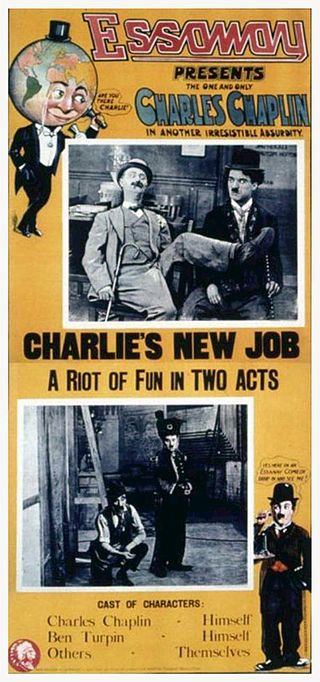
The Chicago film industry is a central hub for motion picture production and exhibition that was established before Hollywood became the undisputed capital of film making. In the early 1900s, Chicago boasted the greatest number of production companies and filmmakers. Essanay Studios founded by George K. Spoor was one of the earliest successful studios to produce movies in Chicago, employing stars such as Charlie Chaplin and Gloria Swanson. Actor and co-founder of Essanay Studios, Broncho Billy Anderson gave birth to the western genre. Early film companies such as Essanay Studios produced multiple silent films every week and rented viewing equipment to showcase the latest cinematography to the public. This rental culture gave birth to the popularity of Nickelodeons up until the Great Depression. However, due to the high demand for motion pictures during this time, a black market for films and equipment developed. The Motion Picture Patents Company, established in 1909 as a conglomerate of the major studios, sought to eliminate all illegal use of patented film equipment. As a result, independent ventures entered the film scene. Independents drove the film industry to the west to avoid legal trouble with the trust of major film companies united under the Motion Picture Patents Company. The west offered fairer weather and scenery that better accommodated film making. Not until the 1980s and early 21st century has Chicago experienced a film production revival. Blockbusters, such as Blues Brothers, Sixteen Candles, and The Dark Knight, have rejuvenated the Chicago film scene.

Gladys Hulette was an American silent film actress from Arcade, New York, United States. Her career began in the early years of silent movies and continued until the mid-1930s. She first performed on stage at the age of three and on screen when she was seven years old. Hulette was also a talented artist. Her mother was an opera star.

Florence Auer was an American theater and motion picture actress whose career spanned more than five decades.
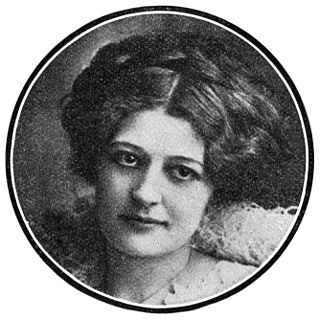
Betty Harte (1882–1965) was a leading lady during the heyday of the silent film era, starring in nine feature films and 108 short films. She is credited with writing four screenplays. She chose Betty Harte as her professional name in honor of her favorite author, Bret Harte.

Frank Beal was an American actor and film director of the silent film era.

Margaret Illington was an American stage actress popular in the first decade of the 20th century. She later made an attempt at silent film acting by making two films with Adolph Zukor's Famous Players–Lasky franchise.
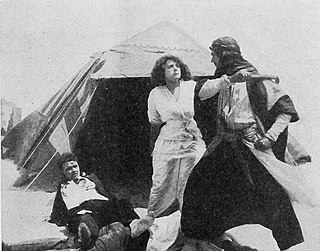
The Carpet from Bagdad is a 1915 American silent adventure film directed by Colin Campbell and based on Harold MacGrath's 1911 eponymous novel. In the story, Horace Wadsworth, one of a gang of criminals also planning a bank robbery in New York, steals the titular prayer rug from its Baghdad mosque. He sells the carpet to antique dealer George Jones to fund the robbery scheme. But the theft places both men and Fortune Chedsoye, the innocent daughter of another conspirator, in danger from the carpet's guardian.
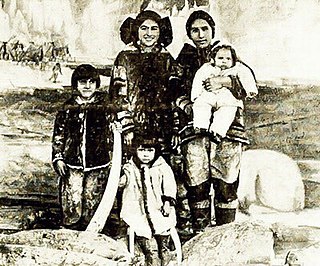
The Way of the Eskimo is a lost 1911 American silent drama film that portrayed the Inuit or "Eskimo" culture of northeastern Canada along the coast of Labrador. Directed by William V. Mong and produced by Selig Polyscope Company, this "photoplay" was based on a love story written by Columbia Eneutseak, a young Inuit woman who was born in the United States in 1893, in the "Esquimaux Village" exhibition at the World's Columbian Exposition in Chicago. She, fellow Inuit performer Zacharias Zad, and William Mong costarred in the film with a supporting cast that included members of Columbia's immediate family and other Inuit players. While this production was promoted in 1911 as being filmed on location in northern Canada, it was actually shot that year at the snow-covered port town of Escanaba, Michigan, along a frozen stretch of shoreline of Little Bay de Noc, which connects to Lake Michigan.
